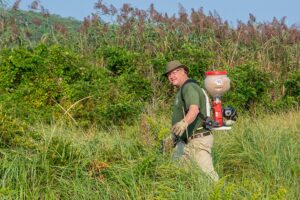PROVINCETOWN — Eastern equine encephalitis (EEE) was detected in a sample of mosquitoes taken here on Sept. 21. Like the August discovery of West Nile virus in Eastham mosquitoes, the disease was found by the Cape Cod Mosquito Control Project, which monitors the insects for these diseases across the Cape.
The presence of the diseases is not cause for alarm so much as it is a reason for people to take precautions to prevent mosquito bites.
In response to the news, the Dept. of Public Health upgraded the risk of EEE from “remote” to “low” in Provincetown, Truro, and Wellfleet. The risk in Eastham remains remote.
According to entomologist Gabrielle Sakolsky, superintendent of the Mosquito Control Project, the organization has detected the virus in Outer Cape mosquitoes twice before, both times in Truro in 2019 during a statewide outbreak.
Elsewhere in Massachusetts, the DPH lists nine towns in the south-central part of the state as being at “high” risk for EEE.
EEE rarely affects people. In the last 85 years, only 115 confirmed cases have been observed in humans in Massachusetts, according to the DPH. Despite its rarity, it is very deadly — half the people who contract the disease die of swelling and inflammation of the brain.
The infected mosquito in Provincetown was of the species Culiseta melanura, the main vector for EEE, which almost never bites humans and mostly feeds on birds. In order for EEE to reach humans from Culiseta melanura, it would first need to travel to a bird, then to another species of mosquito that bites both birds and mammals, known as a “bridge vector.”
This need for an intermediary species to be part of the infection pathway lowers the risk of the disease reaching humans.
Sakolsky said that scientists have not identified with confidence which mosquito species are the principal bridge vectors of EEE. Many of the mosquito species that bite both birds and humans, she said, “are not very good at transmitting eastern equine encephalitis.”
Regardless of its rarity, Sakolsky warned, it is wise to take precautions. The best measures are to wear long sleeves and pants, spray yourself with an EPA-approved repellent, and go inside if you cannot avoid being bitten. The risk of the disease will go down after the first hard frost, which kills most mosquitoes.

